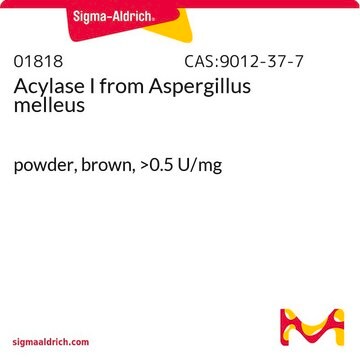Wichtige Dokumente
A8376
Acylase I aus Schweineniere
Grade II, salt-free, lyophilized powder, 300-1,500 units/mg protein
Synonym(e):
Aminoacylase, N-Acylaminosäure-Amidohydrolase
Größe auswählen
243,00 €
Versandbereit am07. April 2025Details
Größe auswählen
About This Item
243,00 €
Versandbereit am07. April 2025Details
Empfohlene Produkte
Typ
Grade II
Form
salt-free, lyophilized powder
Spezifische Aktivität
300-1,500 units/mg protein
UniProt-Hinterlegungsnummer
Lagertemp.
−20°C
Angaben zum Gen
pig ... ACY1(396930)
Suchen Sie nach ähnlichen Produkten? Aufrufen Leitfaden zum Produktvergleich
Anwendung
Biochem./physiol. Wirkung
Einheitendefinition
Hinweis zur Analyse
Signalwort
Danger
H-Sätze
Gefahreneinstufungen
Eye Irrit. 2 - Resp. Sens. 1 - Skin Irrit. 2 - STOT SE 3
Zielorgane
Respiratory system
Lagerklassenschlüssel
11 - Combustible Solids
WGK
WGK 1
Flammpunkt (°F)
Not applicable
Flammpunkt (°C)
Not applicable
Persönliche Schutzausrüstung
Eyeshields, Gloves, type N95 (US)
Hier finden Sie alle aktuellen Versionen:
Analysenzertifikate (COA)
Die passende Version wird nicht angezeigt?
Wenn Sie eine bestimmte Version benötigen, können Sie anhand der Lot- oder Chargennummer nach einem spezifischen Zertifikat suchen.
Besitzen Sie dieses Produkt bereits?
In der Dokumentenbibliothek finden Sie die Dokumentation zu den Produkten, die Sie kürzlich erworben haben.
Aktive Filter
Unser Team von Wissenschaftlern verfügt über Erfahrung in allen Forschungsbereichen einschließlich Life Science, Materialwissenschaften, chemischer Synthese, Chromatographie, Analytik und vielen mehr..
Setzen Sie sich mit dem technischen Dienst in Verbindung.










